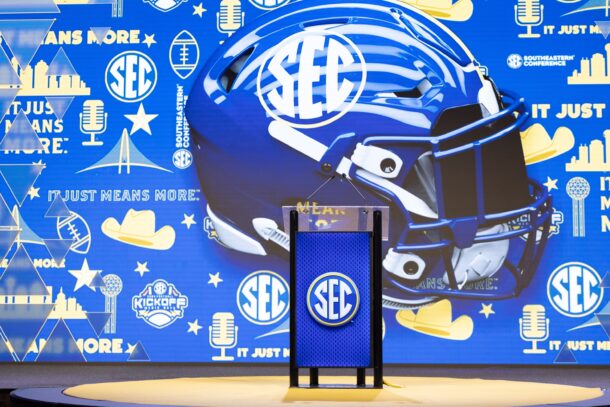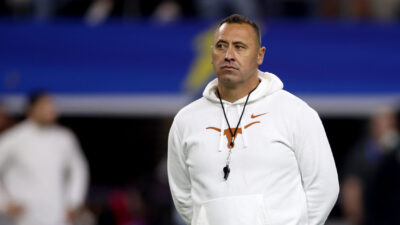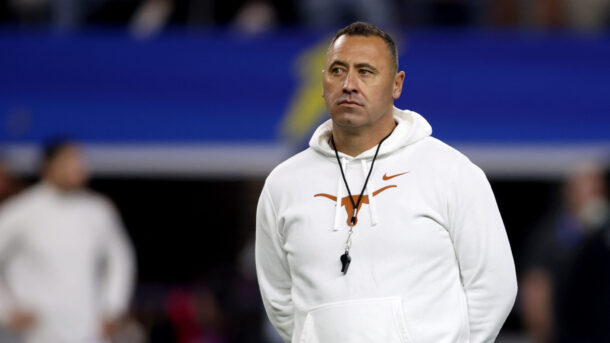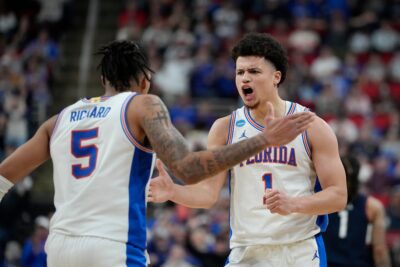Ad Disclosure

O’Gara: Where do the Oklahoma/Texas running back greats rank among SEC legends?
I’m not doing the thing where I refer to Adrian Peterson as “an SEC legend.” OK. Know that.
I’ve seen some notable publications/TV networks struggle with that premise. I’m not here to call them out.
On second thought, I don’t care. Big Ten Network putting a Tom Osborne-coached Nebraska team in its “Big Ten’s Greatest Games” rotation is comical. I realize that a certain amount of programming is retired for each team, but why can’t it be rebranded to “Nebraska’s Greatest Games” for the teams that joined the conference late? Who is pushing back on that?
OK, rant over.
This ranking will undoubtedly upset plenty of people because ultimately, my goal is to rank 6 of the best running backs in the history of college football. This ranking is only for 6 backs — Billy Sims, Ricky Williams, Adrian Peterson, Earl Campbell, Bo Jackson and Herschel Walker — because I think we can all agree on 2 things: One is that Walker and Jackson are the best running backs in SEC history. The other is that Sims, Williams, Peterson and Campbell are the best running backs in Oklahoma/Texas history.
Five of those 6 running backs won a Heisman Trophy, and you could argue that the one who didn’t (Peterson) was the most unstoppable force of them all during his runner-up season as a true freshman in 2004.
That’s why this is a fun discussion. To critique is to split hairs.
So, let’s begin this impossible ranking:
6. Billy Sims, Oklahoma
I mean, we’re starting this list with a guy who had a Heisman season and a Heisman runner-up season. No true negatives are working against Sims, who had a 2-year stretch to close his college career that included a ridiculous 3,566 yards and 45 touchdowns (including bowl games). He averaged north of 7 yards per carry during his time as a starter for an Oklahoma team that went a combined 22-2 in 1978 and 1979. Sims finished his career as the program’s all-time leading rusher.
The only thing working against Sims in this discussion is that the first 3 years of his career were slowed by injuries. He only had 552 career rushing yards entering his 4th college season. Sims only gets knocked compared to the others on this list for the simple fact that he had a significant chunk of his college career in which he wasn’t able to be the backbone of Barry Switzer’s offense.
But yeah, you could still argue that Sims’ 2-year run is among the top 3 or 4 such stretches that we’ve ever seen in college football.
5. Ricky Williams, Texas
How hard is it to rank these backs? At one point, I had Williams as high as No. 2. That’s how much I think of him. For my generation, he was one of the first appointment-viewing players that I remember. I still remember the day that Mike Ditka mortgaged his entire future by trading all of those picks to get Williams. But well before Williams’ winding road of an NFL career began, he was the best Texas back since Earl Campbell. Some would argue that Williams was even better.
One thing working in Williams’ favor is the fact that statistically speaking, he’s untouchable. His 6,279 career rushing yards are No. 3 all-time — he left school as the NCAA’s all-time leading rusher — and that didn’t even include his bowl game stats. A 361-carry, 2,124-yard season would be insane over the course of 15 games. The fact that Williams pulled that off in just 11 games is one of the all-time individual seasons.
The only reason that Williams isn’t higher on this list is because if you’re giving me the schoolyard option of starting my backfield, I’m taking the 4 players listed higher on this list. Is that subjective? Sure, but even (some) Texas fans would agree with that point.
4. Adrian Peterson, Oklahoma
Outside of 1980 Herschel, I don’t know that we’ve ever seen a true freshman as good as 2004 AD. And yeah, it’s “AD” because “All Day,” he ran it down your throat. It was like we were watching a taller version of Campbell. Of course, Oklahoma fans would argue that Peterson was even better than Campbell. At his peak, you could certainly make that case. Peterson’s 1,925-yard campaign would’ve earned him the Heisman if he were an upperclassman. Period. To that point, we had still never even seen a sophomore win the award, much less a true freshman.
The only critique of Peterson is that he never quite repeated that freshman season. Injuries limited him in his final 2 seasons, though both of which were still 1,000-yard seasons. When healthy, Peterson’s violent nature was a sight to behold. Bulldozing his way through the first level of a defense and splitting a secondary en route to the end zone became a common occurrence for Peterson. I’ll put Peterson’s highlight reel among any who have ever played college football.
We could watch highlights of @AdrianPeterson at @OU_Football ALL DAY long. pic.twitter.com/x5YyQJEFkZ
— CBS Sports (@CBSSports) May 9, 2020
3. Bo Jackson, Auburn
Jackson is tricky to rank in columns like this because the written word doesn’t do his legend justice. To understand the legend of Bo, you had to watch how effortlessly he moved at that size. There’s a case to be made that he’s the most physically gifted athlete in the history of American sports. It’s amazing that Jackson’s athleticism was so revered even after Walker took the SEC by storm. That was the only person that Jackson couldn’t pass on the SEC’s all-time rushing list.
If there’s a reason Jackson isn’t even higher on this list, it’s because the first 3 years of his career were more about the flashes of brilliance for the 2-sport megastar than the total body of work. “Bo Over the Top” is an iconic SEC play that helped launch Jackson into a different stratosphere as a true freshman in 1982, and his 256-yard rushing performance a year later in the 1983 Iron Bowl is still talked about 4 decades later.
Bo Jackson became an Auburn legend in the 1982 Iron Bowl, but the 1983 Iron Bowl is the moment that rocketed him to superstardom . #RBRespectMonth
https://t.co/IvsRmNqOz8 pic.twitter.com/F9yjzZVPTS
— Colton Denning (@Dubsco) March 12, 2024
Jackson’s 1985 Heisman Trophy campaign was his lone season in which he earned unanimous All-America honors. Because of a lost junior season, his career wasn’t quite as complete as others on this list, though the highlights stack up against any running back before or after he left Auburn. ESPN ranked him the No. 3 player in the history of college football, so I suppose that being No. 3 on this list will be considered “disrespectful.”
Don’t get it twisted, though. Jackson’s legacy deserves nothing but respect.
2. Earl Campbell, Texas
It’s wild to think that from 1974-85, Campbell, Sims, Walker, Jackson and Eric Dickerson all played college football. (Not to mention Archie Griffin and Tony Dorsett.) Was that the golden era of running backs? I wouldn’t push back on that, nor would I push back on anyone who said that Campbell changed the way we viewed the running back position.
Before there was Dickerson, Herschel and Bo, there was the 230-pound Tyler, Texas, native who ran like a deer and swatted off arm tackles like they were mosquitos. The power that he ran with was unmatched. Whether it was the devastating stiff arm or his tree trunks for legs, Campbell initiated contact like no back before him.
He finished his college career No. 5 all-time in rushing (4,443 yards), but the way that Campbell earned those yards felt different. Few backs could humiliate you quite like Campbell. Much like Jackson, who probably could’ve taken on even more work as an underclassman, Campbell shook off an injury-shortened junior season by becoming Texas’ first Heisman winner as a senior.
There’s no denying that he could’ve — and would have — dominated in any era of football.
1. Hershel Walker, Georgia
It’s one of the all-time radio calls by legendary Georgia announcer Larry Munson.
“He’s running over people! My God almighty, he ran through 2 men! My God … a freshman!”
Herschel’s college legacy changed the night in Knoxville when he ran through Bill Bates. For the rest of Herschel’s career, he was the entire focal point of Georgia’s offense and he was the entire focal point of whatever defense he was facing. There was no such thing as a 3- or 4-man front that running backs today get to run through. You had to crowd the line of scrimmage to prevent Herschel from getting any sort of head of steam because once he did that? Forget about it.
Herschel should’ve won the Heisman as a true freshman (he finished 3rd) when he led the Dawgs to a national title, he was a runner-up as a sophomore and despite seeing nothing but loaded boxes as the most popular player in the sport as a junior, he ran for 1,752 yards in 11 games en route to the Heisman. From the moment that Herschel stepped onto a college field to the moment he left it after the 1982 season, he was the best player in the sport.
My God almighty, indeed.
Connor O'Gara is the senior national columnist for Saturday Down South. He's a member of the Football Writers Association of America. After spending his entire life living in B1G country, he moved to the South in 2015.




